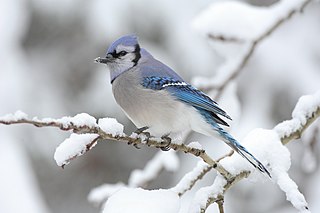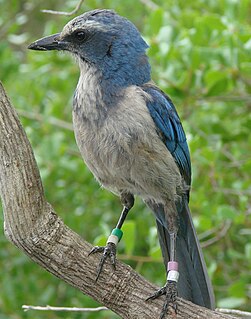
Corvidae is a cosmopolitan family of oscine passerine birds that contains the crows, ravens, rooks, jackdaws, jays, magpies, treepies, choughs, and nutcrackers. In common English, they are known as the crow family, or, more technically, corvids. Over 120 species are described. The genus Corvus, including the jackdaws, crows, rooks, and ravens, makes up over a third of the entire family. Corvids are the largest passerines.

The passerine birds of the genus Aphelocoma include the scrub-jays and their relatives. They are New World jays found in Mexico, western Central America and the western United States, with an outlying population in Florida. This genus belongs to the group of New World jays–possibly a distinct subfamily–which is not closely related to other jays, magpies or treepies. They live in open pine-oak forests, chaparral, and mixed evergreen forests.

The island scrub-jay also island jay or Santa Cruz jay is a bird in the genus, Aphelocoma, which is endemic to Santa Cruz Island off the coast of Southern California. Of the over 500 breeding bird species in the continental U.S. and Canada, it is the only insular endemic landbird species. The island scrub-jay (ISSJ) is closely related to the California scrub-jay – the coastal population found on the adjacent mainland – but differs in being larger, more brightly colored, and having a markedly stouter bill. They will bury, or cache, the acorns in the fall and may eat them months later. They also eat insects, spiders, snakes, lizards, mice and other birds' eggs and nestlings.

The Mexican jay formerly known as the gray-breasted jay, is a New World jay native to the Sierra Madre Oriental, Sierra Madre Occidental, and Central Plateau of Mexico and parts of the southwestern United States. In May 2011, the American Ornithologists' Union voted to split the Mexican jay into two species, one retaining the common name Mexican jay and one called the Transvolcanic jay. The Mexican jay is a medium-sized jay with blue upper parts and pale gray underparts. It resembles the western scrub jay, but has an unstreaked throat and breast. It feeds largely on acorns and pine nuts, but includes many other plant and animal foods in its diet. It has a cooperative breeding system where the parents are assisted by other birds to raise their young. This is a common species with a wide range and the International Union for Conservation of Nature has rated its conservation status as being of "least concern".

The California scrub jay is a species of scrub jay native to western North America. It ranges from southern British Columbia throughout California and western Nevada near Reno to west of the Sierra Nevada. The California scrub jay was once lumped with Woodhouse's scrub jay and collectively called the western scrub jay. The group was also lumped with the Island scrub jay and the Florida scrub jay; the taxon was then called simply the scrub jay. The California scrub jay is nonmigratory and can be found in urban areas, where it can become tame and will come to bird feeders. While many refer to scrub jays as "blue jays", the blue jay is a different species of bird entirely. In recent years, the California scrub jay has expanded its range north into the Tsawwassen region of British Columbia.

The unicolored jay is an Aphelocoma jay native to cloud forests of northwestern Central America and southern and southeastern Mexico, from central Honduras west to central Guerrero, southern Veracruz and extreme southern San Luis Potosí. It is apparently a basal member of its genus. At Montebello, Chiapas, it is a cooperative breeder.

Hoarding or caching in animal behavior is the storage of food in locations hidden from the sight of both conspecifics and members of other species. Most commonly, the function of hoarding or caching is to store food in times of surplus for times when food is less plentiful. However, there is evidence that some amount of caching or hoarding is done in order to ripen the food, called ripening caching. The term hoarding is most typically used for rodents, whereas caching is more commonly used in reference to birds, but the behaviors in both animal groups are quite similar.

Samuel Washington Woodhouse was an American surgeon, explorer and naturalist.

The Lake Wales Ridge National Wildlife Refuge is part of the United States National Wildlife Refuge (NWR) System, located in four separated areas on the Lake Wales Ridge east of US 27 between Davenport and Sebring Florida. The 1,194 acre (4.8 km2) refuge was established in 1990, to protect a host of plants and animals. It is also the first to be designated primarily for the preservation of endangered plants, and is not open to the general public. It contains a high proportion of remaining Florida scrub habitat. It is administered as part of the Merritt Island National Wildlife Refuge.

Florida sand pine scrub is an endangered subtropical forest ecoregion found throughout Florida in the United States. It is found on coastal and inland sand ridges and is characterized by an evergreen xeromorphic plant community dominated by shrubs and dwarf oaks. Because the low-nutrient sandy soils do not retain moisture, the ecosystem is effectively an arid one. Wildfires infrequently occur in the Florida scrub. Most of the annual rainfall falls in summer. It is endangered by residential, commercial and agricultural development, with the largest remaining block in and around the Ocala National Forest. Lake Wales Ridge National Wildlife Refuge also holds a high proportion of remaining scrub habitat, while the Archbold Biological Station near Lake Placid contains about 20 km2 (7.7 sq mi) of scrub habitat and sponsors biological research on it.

The Florida scrub jay is one of the species of scrub jay native to North America. It is the only species of bird endemic to the U.S. state of Florida and one of only 15 species endemic to the continental United States. Because of this, it is heavily sought by birders who travel from across the country to observe this unique species. It is known to have been present in Florida as a distinct species for at least 2 million years, and is possibly derived from the ancestors of Woodhouse's scrub jay.

Salinas River State Beach is a beach at the river mouth of the Salinas River at Monterey Bay, in Monterey County, California.
A. californica may refer to:

Conradina etonia is a rare species of shrub in the mint family known by the common name Etonia rosemary. It is endemic to Putnam County, Florida, where it is known from about 8 populations on Etoniah Creek State Forest containing fewer than 1000 total individuals. It has a specific habitat requirement and the main threat it faces is destruction and degradation of its habitat. It is a federally listed endangered species of the United States.

The Transvolcanic jay is a medium-large passerine bird similar in size to most other jays, with a blue head, blue-gray mantle, blue wings and tail, gray breast and underparts. The sexes are morphologically similar, and juveniles differ only in having less blue coloration. The iris is brown and legs are black. It is most readily distinguished by the plain (unstreaked) throat and breast, and the mantle contrasting less with the head and wings.

Woodhouse's scrub jay, is a species of scrub jay native to western North America, ranging from southeastern Oregon and southern Idaho to central Mexico. Woodhouse's scrub jay was until recently considered the same species as the California scrub jay, and collectively called the western scrub jay. Prior to that both of them were also considered the same species as the island scrub jay and the Florida scrub jay; the taxon was then called simply the scrub jay. Woodhouse's scrub jay is nonmigratory and can be found in urban areas, where it can become tame and will come to bird feeders. While many refer to scrub jays as "blue jays", the blue jay is a different species of bird entirely. Woodhouse's scrub jay is named for the American naturalist and explorer Samuel Washington Woodhouse.
The Florida peninsula inland scrub is a shrubland community found on the Florida peninsula. The largest remaining blocks of inland scrub are in and around the Ocala National Forest and in the Lake Wales Ridge National Wildlife Refuge. The Archbold Biological Station near Lake Placid contains about 20 km2 (7.7 sq mi) of scrub habitat and sponsors biological research on it. The scrub occurs on a series of north-south running ridges composed of sand derived from ancient dune fields. The soil, a type of entisol, is derived from quartz and is low in organic matter, silt, and clay. Because the low-nutrient sandy soils do not retain moisture, the ecosystem is effectively an arid one.














